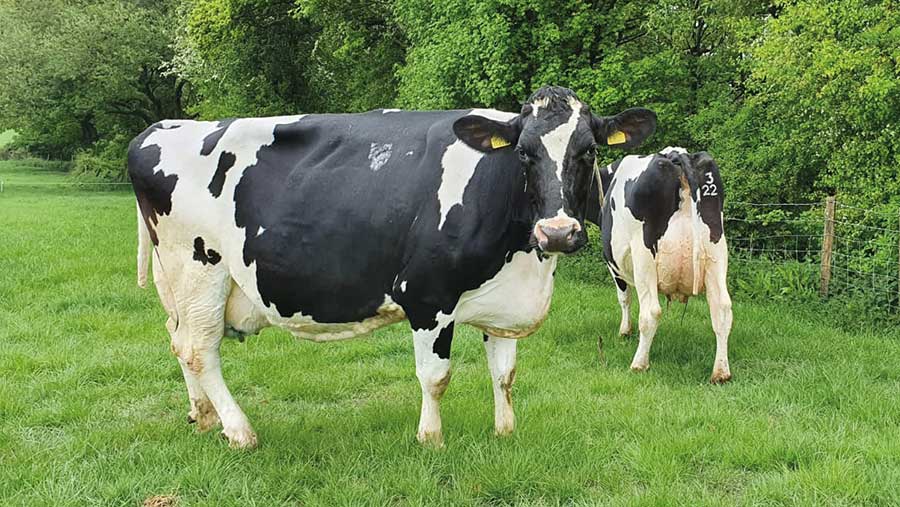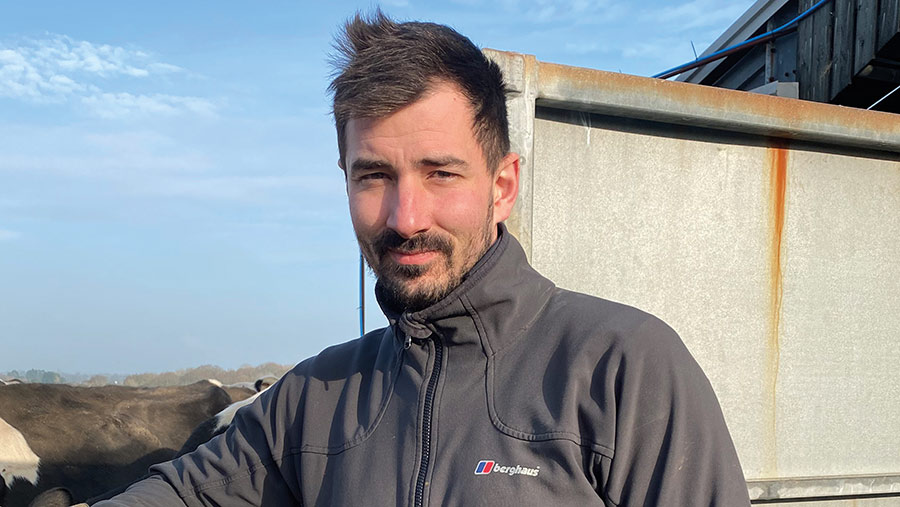Selecting cows for milk solids improves Sussex dairy’s yield
 Huddlestone Farm dairy cow and heifer © Keith Gue
Huddlestone Farm dairy cow and heifer © Keith Gue The year-round calving herd at Huddlestone Farm, Steyning, produces a milk yield average of 37 litres a cow a day at 4.22% butterfat and 3.42% protein.
In contrast, in 2017 the herd was averaging 34 litres at 3.91% butterfat and 3.23% protein.
Although some of this uplift is down to improved herd management, farmer Keith Gue estimates at least 50% of it is the result of genetics.
See also: How a dairy farmer improved herd performance through genetics
His aim is to breed healthy, functional and profitable cows. To achieve this, data is imperative, says Mr Gue, who farms with his parents, Tim and Marion, and brothers Ryan and Matt.
Farm facts
Huddlestone Farm, Steyning, West Sussex
- 809ha (2,000 acres) farmed
- Mixed farm with dairy, sheep, beef and arable enterprises
- 10 staff employed across the business together with family labour
- Cows milked in a 32-point internal rotary parlour
Performance analysis
He regularly evaluates milk-recording results, production records and locomotion-scoring data in combination with herd health and medicine records.
These are an important starting point to validating his herd’s genetic performance and identifying the future genetic direction of the herd.
The first step is to compare the herd’s actual performance with its predicted genetic ability.
“We record as much as we can and marry up the results with the genetic traits we need to improve on, and use that to inform our breeding policy,” says Mr Gue.
“There is no point breeding for a trait that doesn’t yield results, but you need to get into the nitty gritty of the data to really work that out.”
Over the past decade, focus has shifted from selecting for milk and health traits to targeting weight of fat and protein.
Long-term view
Although the farm has a liquid supply contract – it supplies Tesco via Arla – Mr Gue says every dairy farm should take a long-term view on milk sales.
“We have been Tesco Sustainable Dairy Group members since 2008 and would never look to leave, but we are also aware that a milk contract is not for life.
“For us, should our contract change, we want cows that can meet demand for milk solids. Fats and proteins are key to it.”
The herd is housed, with the high-yielding cows milked three times a day and the low yielders grazed when possible and milked twice a day.
The aim is to be high yielding but to maximise yield from forage.
“Our annual average was rolling over 3,000 litres from forage, but that has moved back to 2,665 litres due to a lack of forage available after the summer drought,” Mr Gue says.
Genetic selection
The business aims to produce the highest genetic merit heifers possible, selecting a bull group that meets specific averages on milk solids, reduced body size and longevity.
Mr Gue knows how many replacements he needs each month, breeding from his best cows and matching these to bulls that can deliver on his breeding goals.
“Optimising our heifer inventory is probably one of the biggest opportunities to reduce waste on the dairy – it allows us to reduce costs in the business to make us more efficient and sustainable,” he says.
“By breeding from our best females, we are increasing the genetic value of our replacements and gradually reducing the number of lower-genetic-merit animals coming in.”
All cows are ranked on average profitable lifetime index (PLI).
“PLI is about right for us – maybe not extreme enough on production or reduced body size, but it is the best index there is for our system,” says Mr Gue.
The milking herd has an average PLI of £321 and the average of heifers due for service is £561.
“I put a line in the sand – everything, or nearly everything, below that line is served to beef and everything above to dairy,” he says.
“Managing that every month allows us to be as efficient as we can. We don’t want too many spare heifers knocking around.
“Those bottom-end heifers just take up resources and mean that you do a worse job of looking after the ones you do want.”
For the past four years, Sexcel semen has been used for first and second service on all animals served to dairy. Maiden heifers that don’t quite make the grade genetically are served to beef.

© Keith Gue
“It just doesn’t pay to generate a Holstein heifer that we know will be at the bottom of the pile,” says Mr Gue.
Getting the replacement rate right is important – it had been as low as 17% and as high as 29%, but is now averaging 23%.
An older herd is a more productive one, Mr Gue adds. “Keeping the replacement rate as low as possible is where the profit lies. The more days we get out of these cows, the fewer replacements we need to breed.
“However, it is important to make sure the cows we keep are productive – significantly dropping replacement rate can lead to increased mortality if you’re not careful.”
Genetic progress
The AHDB Dairy Herd Genetic Report is used to monitor the herd’s predicted transmitting ability.
This allows Mr Gue to check the genetic progress made over the generations and informs sire selection to improve the next generation of heifers coming into the herd.
There is emphasis on reducing bodyweight – the long-term aim is to not have mature cows much heavier than 600kg.
Cows do not need to be big to produce large volumes of milk, and big cows just eat more feed to maintain themselves, Mr Gue reasons.
“We use maintenance [index] pretty hard to select on both the male and female side.
“We just don’t need to be breeding those big cows that eat more, don’t produce more milk and probably end up causing us more problems when things do go wrong.”
He balances the selection on maintenance by looking for balance between stature and chest width indexes. Tall, narrow cows might not weigh much, but he finds they leave the herd quite quickly.
Milk solids are essential, too – the Gues will keep their focus on breeding for good butterfat and protein.
A further goal is to improve the lifespan index as much as possible – it is the ultimate trait, he argues, because it allows selection for so many traits at once.
It reflects many contributory factors, from fertility to feet, and it has a strong correlation with an animal’s average daily lifetime yield, which is a key contributor to its lifetime profitability.
“We want a cow that is not going to leave the herd involuntarily,” he says.
“The biggest waste on any dairy is when cows don’t leave the farm alive and don’t manage to enter the food chain, and when milk doesn’t make it into the tank.”
